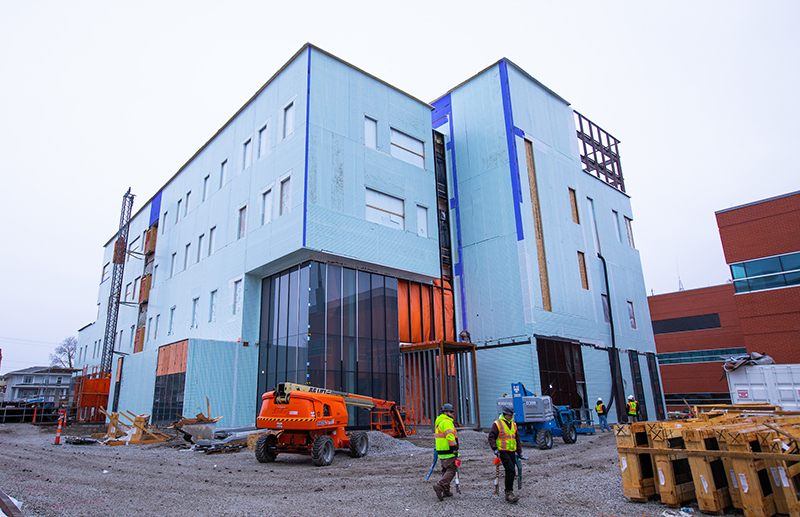Happy birthday, Iowa State
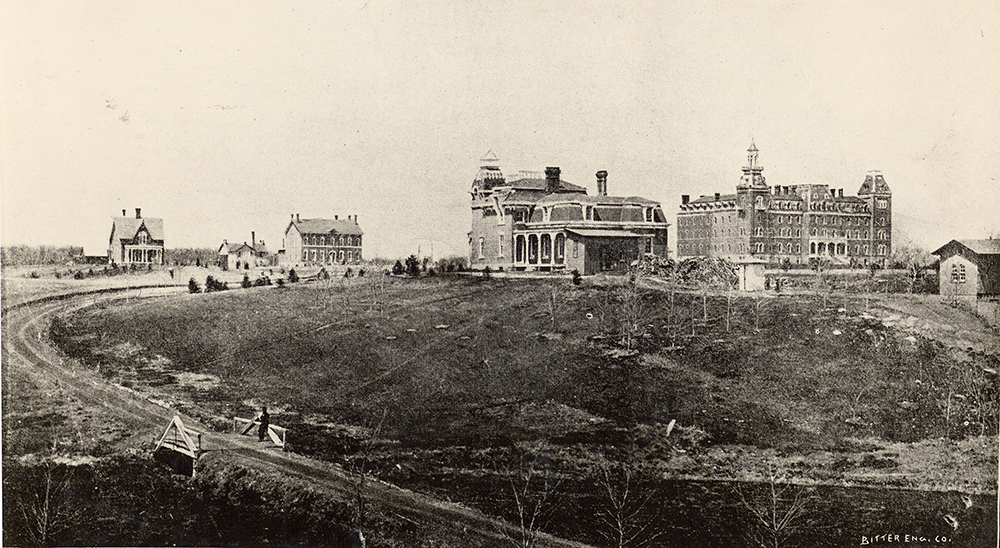
The Maples, Old Chemistry Building, President's residence and Old Main, circa 1876.
The large building (right) is the Main Building, built in 1868 with a wing added in 1871. The building in the foreground is the president's residence, built in 1869. At far left (rear) is the Maples, also completed in 1869, later known as Music Hall. To the right of the Maples is the Chemistry Building, built in 1870 with an addition in 1875. The smaller building behind Chemistry is not identified. Photo courtesy of Iowa State University Library Special Collections and University Archives.
Friday, March 22, is Iowa State University's 166th birthday (some prefer founder's day). The count starts from that spring day in 1858 the Iowa General Assembly passed a bill to establish the Iowa State Agricultural College and Model Farm "to be connected with the entire agricultural interest of the State of Iowa."
It took more than 10 years to purchase and erect the beginnings of a college campus and welcome the first students and, while other dates were significant during that period, March 22 remains the date we celebrate as a community of employees, students and alumni.
Most recently, the ISU Alumni Association has led that charge with "State Day" observances. Talbot Endowed President and chief executive officer Jeff Johnson said the intent behind the celebration varies slightly by audience. For current students, it's to encourage a show of loyalty and pride in their school. For alumni, it's to trigger fun memories of classmates and their time at Iowa State.
"We don't have active chapters in all the cities our alumni live, so these broader events give us a chance to serve all of our alumni, no matter where they live," Johnson said.
Instruction to be offered, according to the 1858 legislation:
- Animal and vegetable anatomy
- Book-keeping
- Botany
- Chemistry
- Entomology
- Forestry
- Fruit growing
- Geology
- Horticulture
- Mechanical arts directly connected with agriculture
- Meteorology
- Minerology
- Natural philosophy
- Plain mensuration, levelling and surveying
- Veterinary art
- Zoology
Johnson noted it's important to share an accurate university history in "fun and engaging" ways so the Iowa State community appreciates its shared history.
State Day
State Day launched in 2016 when the Student Alumni Leadership Council (SALC) organized a central campus event with birthday cake and prizes for students who showed up in their Cyclone gear.
The outreach expanded to alumni in 2018 with an email message about Iowa State's establishment in March 1858 and a video about the carillon and campanile, a historic central campus icon and memory maker.
This year, the alumni association ran its first "State Week" March 4-8, a five-day, opt-in email campaign. Each daily note featured a short video story that showcased today's campus to alums: Fountain of the Four Seasons restoration project, 50 years of the M-Shop, Veterinary Medicine's new state diagnostic laboratory, the modern campus dining experience and news highlights from each college.
More than 1,100 alumni and friends opted in to receive the email series -- and many forward it to other friends, Johnson said.
Calling their events "State Day" or "State Week" gives organizers a little flexibility with their planning, he noted. For example, last week's early emails to alumni were designed to not conflict with other communications later this month to alumni around anticipated tournament appearances for the wrestling and women's and men's basketball teams.
SALC's 2024 "State Day" celebration is Tuesday, March 26 (11:30 a.m.-1:30 p.m., central campus) with food, activities and prizes.
A collection of dates for Iowa State
Our start: 1858
The Iowa Legislature established the Iowa Agricultural College and Model Farm on March 22, 1858, though more than a decade would pass before students arrived. The bill appropriated $10,000 to purchase land and build facilities and outlined how an 11-member board of trustees would guide that process. The bill also stipulated that tuition would remain "forever free" -- which it was for more than three decades. The next year, on June 21, 1859, the board selected Story County as the site for the college and purchased the original 648 acres.
Morrill Act: 1862
Iowa was the first state to identify and map the land parcels the federal government gave to states under the Land Grant Colleges Act -- or Morrill Act -- which President Abraham Lincoln signed on July 2, 1862. Two months later, on Sept. 11, the Iowa Legislature met in a special session to become the first state to accept its terms: Sell the land and use the proceeds to establish a land-grant institution open to all and emphasizing agriculture and mechanic arts.
Despite its central Iowa location, none of the federal land given to Iowa State is in the area. The 204,000 acres, sold in 160-acre parcels, are scattered across 27 counties in the northwest quadrant of the state.
In 1864, the Iowa Legislature designated the Ames college, rather than its Iowa City university, as the state's land-grant.
Students arrive: 1869
Adonijah Welch, at the time serving as a U.S. senator from Florida, was appointed the first president in May 1868 and, following a fall session of students completing preparatory work, the college officially opened on March 17, 1869, with 173 students, including 37 women. Three years later, the student body surpassed 260, and 26 students graduated in the first class: 24 men and two women.
Flat-fee plan for course materials shared with senators
ISU Book Store assistant director Heather Dean updated the Faculty Senate on the next phase of immediate access course materials at the group's March 19 meeting.
The bookstore has provided immediate access materials since 2012, allowing students to receive access to digital-only required course materials on the first day of class at a lower cost. The effort has saved Iowa State students a total of $19 million, including more than $2.6 million this academic year, Dean said.
Beginning this fall semester, immediate access will be a digital-first, flat-fee subscription program where all course materials -- digital and print -- are included in one rate for undergraduate students. The materials are available on the first day of class in Canvas, ISU's learning management system. Some materials, like lab manuals and workbooks, will remain as print materials.
"Students receive all of their course materials for one low, flat rate," Dean said. "The overall goal is affordability for our students and ensuring they have access to their materials with a predictable price they can budget for."
The flat-rate cost per semester is $259 for fall and spring semesters and $69 for the winter and summer terms. Prices will be reviewed annually. Students can still opt out for a refund through the 10th day of classes and the bookstore will provide them a purchasing option.
Digital course materials are the preferred method for most students, with 97% using them, Dean said. Eighty-seven percent of course materials at ISU use immediate access.
Faculty still have the option to use physical textbooks and other materials, but digital is the default option unless specified, Dean said.
Responding to regents' diversity directives
As part of the process of implementing the state Board of Regents' 10 directives that resulted from its eight-month review of diversity, equity and inclusion (DEI) programs and offices at the three universities, the senate heard and approved two changes.
-
Directive 6 instructs the regents universities to review "DEI-related general education categories and update category names to accurately reflect the array of options students may select from to satisfy these requirements and ensure a breadth of offerings."
To comply, the academic affairs committee proposed renaming the U.S. diversity requirement category to "U.S. cultures and communities." -
Directive 4b states, "No employee, student, applicant, or campus visitor is compelled to disclose their pronouns."
To bring awareness to the directive, senators approved a change to the required syllabus statement on free expression that adds two sentences: "No employee, student, applicant, or campus visitor is compelled to disclose their pronouns. Anyone may voluntarily disclose their own pronouns."
Fast track for artificial intelligence minor
Senators approved an interdisciplinary undergraduate minor in applied artificial intelligence (AI) in the College of Liberal Arts and Sciences with two required courses, "Introduction to Applied AI" and "Ethical Design, Use and Impact of AI," and three elective courses. The minor -- open to all undergraduates -- focuses on AI literacy and emphasizes ethical considerations. The minor will help students gain employment in jobs that utilize AI. The senate voted to skip a second reading and approved the minor to ensure it could be marketed to prospective, incoming and current students and place ISU among frontrunners offering the minor.
Other business
- Senators approved a name change for the bachelor's and minor in apparel, merchandising and design, to fashion design and merchandising. Fashion is the more common term for everything from student scholarships to trade organizations. The change is expected to help student recruitment.
- The senate approved a resolution encouraging students to take part in the 2024 general election and faculty to not schedule exams or major assignments on Election Day, Nov. 5.
- Sarah Davis, English, was elected a Faculty Senate representative to the athletics council.
- Senators will vote next month on a proposed certificate in health care management from the management and entrepreneurship department. The 20-credit certificate is designed to help students transition from clinical to managerial roles where balancing finances, assessing programs and leading are important. The certificate would be available to all undergraduate students, and could especially benefit students majoring in the businesses, biology and pharmacology.
First phase of diagnostic lab opened last week
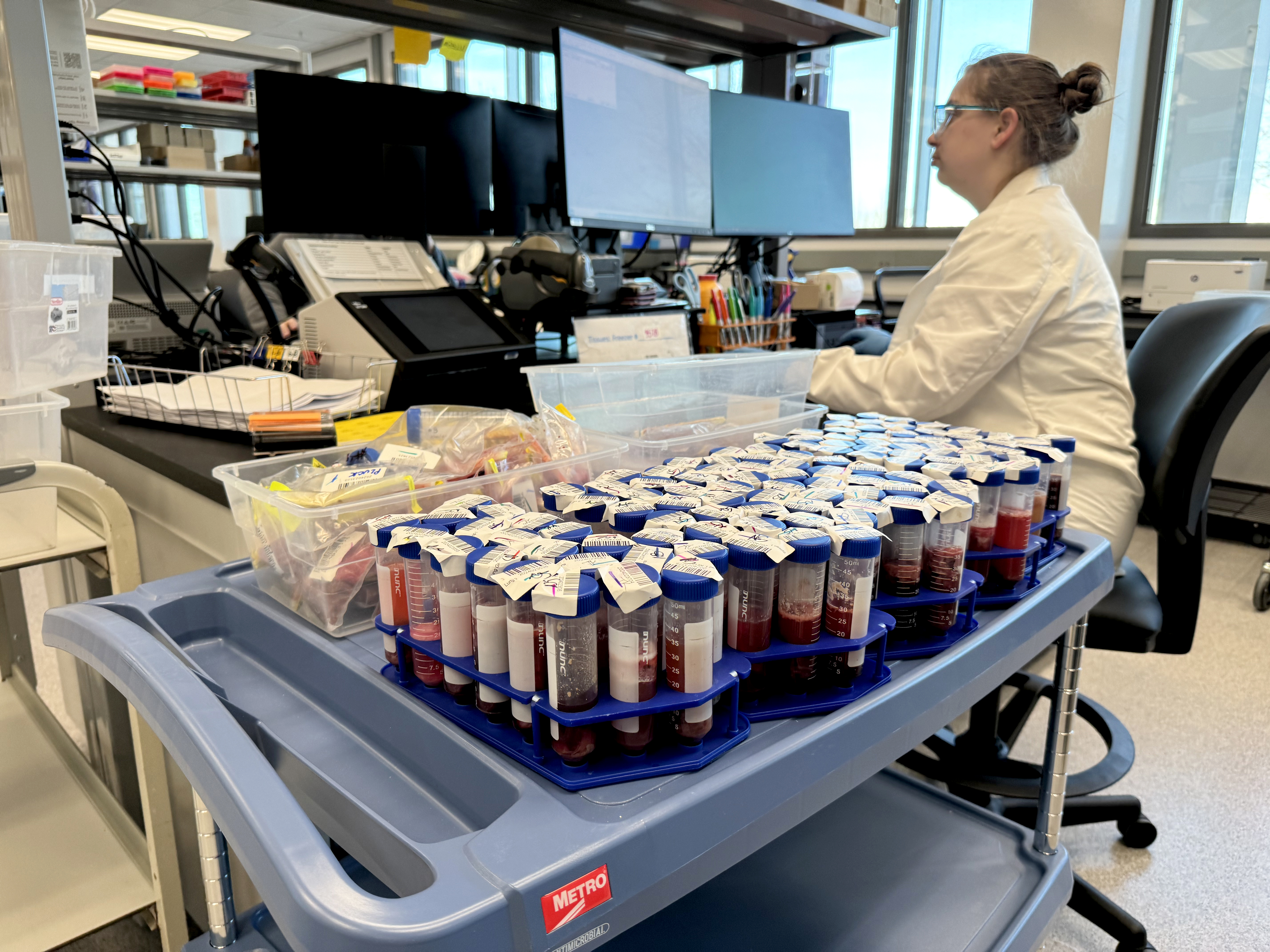
Lab technician Becca Wharton organizes tissue homogenates for storage using the Laboratory Information Management System that tracks location and status. Photos by Dave Gieseke.
The Veterinary Diagnostic Laboratory (VDL) at the College of Veterinary Medicine is operational in its new location across the parking lot from Patterson Hall. Client services, receiving/accessioning, sample processing, necropsy, pathology, histopathology and bacteriology units and the incinerator opened March 11 at the new site.
Construction on the $75 million first phase began in March 2021, supported by $63.5 million in state appropriations over five years. The remaining funding came from private donors and Iowa State.
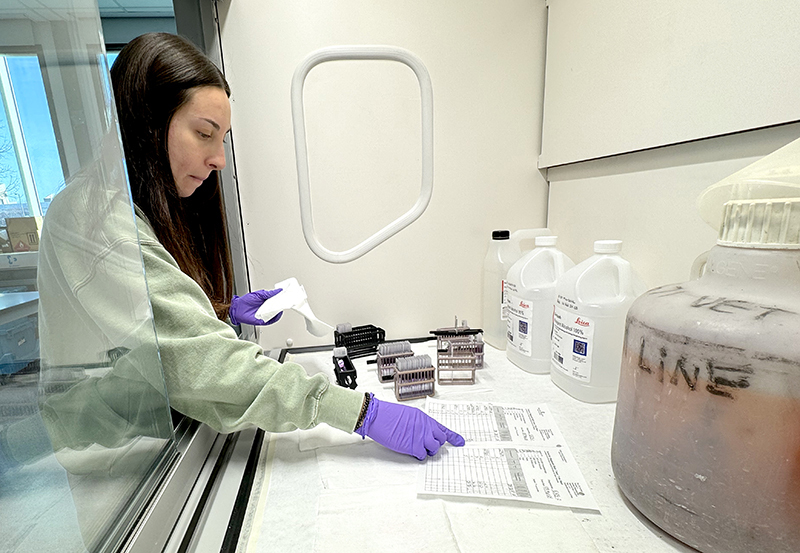
Diagnostic associate Emily Foresta gathers slides from the daily stained and coverslipped tissue sections in preparation for digital imaging.
Construction on the second phase is scheduled to begin this spring with completion anticipated in 2026. It will house the remaining VDL sections: molecular diagnostics, genetic sequencing, virology, serology, analytical chemistry, toxicology, biosafety level 3 laboratory, diagnostic research and development, information technology and quality assurance, and administrative offices, which will continue to operate in their Patterson Hall locations until phase 2 is completed.
The 2023 Legislature approved $18 million in state support this year for phase 2. And in January 2023, Gov. Kim Reynolds pledged $40 million in state support from funds directed to Iowa in the American Rescue Plan Act of 2021, the U.S. Congress' third major pandemic recovery package. Private gifts and university funds will make up the rest of the proposed $66.5 million project.
A dual celebration will be held Thursday, April 4, to dedicate phase 1 and break ground on phase 2.
Iowa State's VDL has been a national leader in protecting animal and human health since it was established in 1947. The facility has the largest food animal caseload in the country while serving the most progressive livestock and poultry producers in the world. Annually, the facility sees more than 120,000 cases and conducts 1.6 million tests.
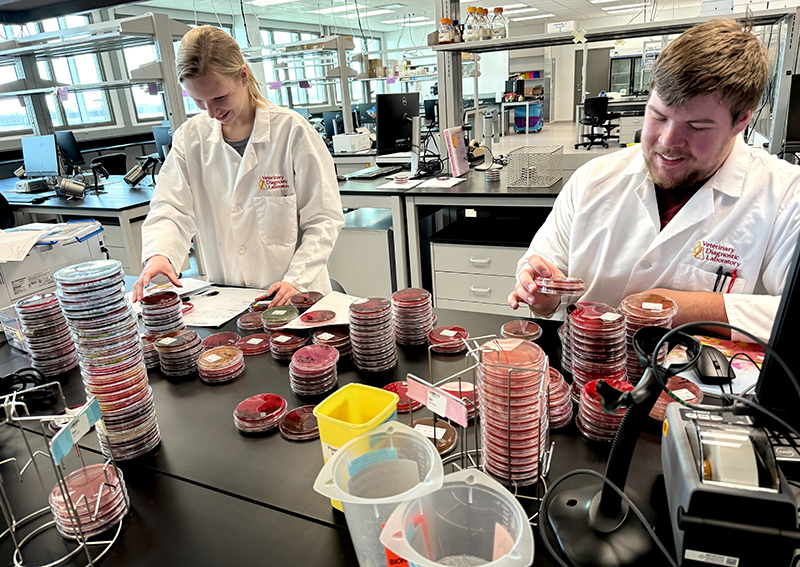
Diagnostic associate Karissa Lageson (left) and student employee Logan Proctor sort bacterial culture plates.
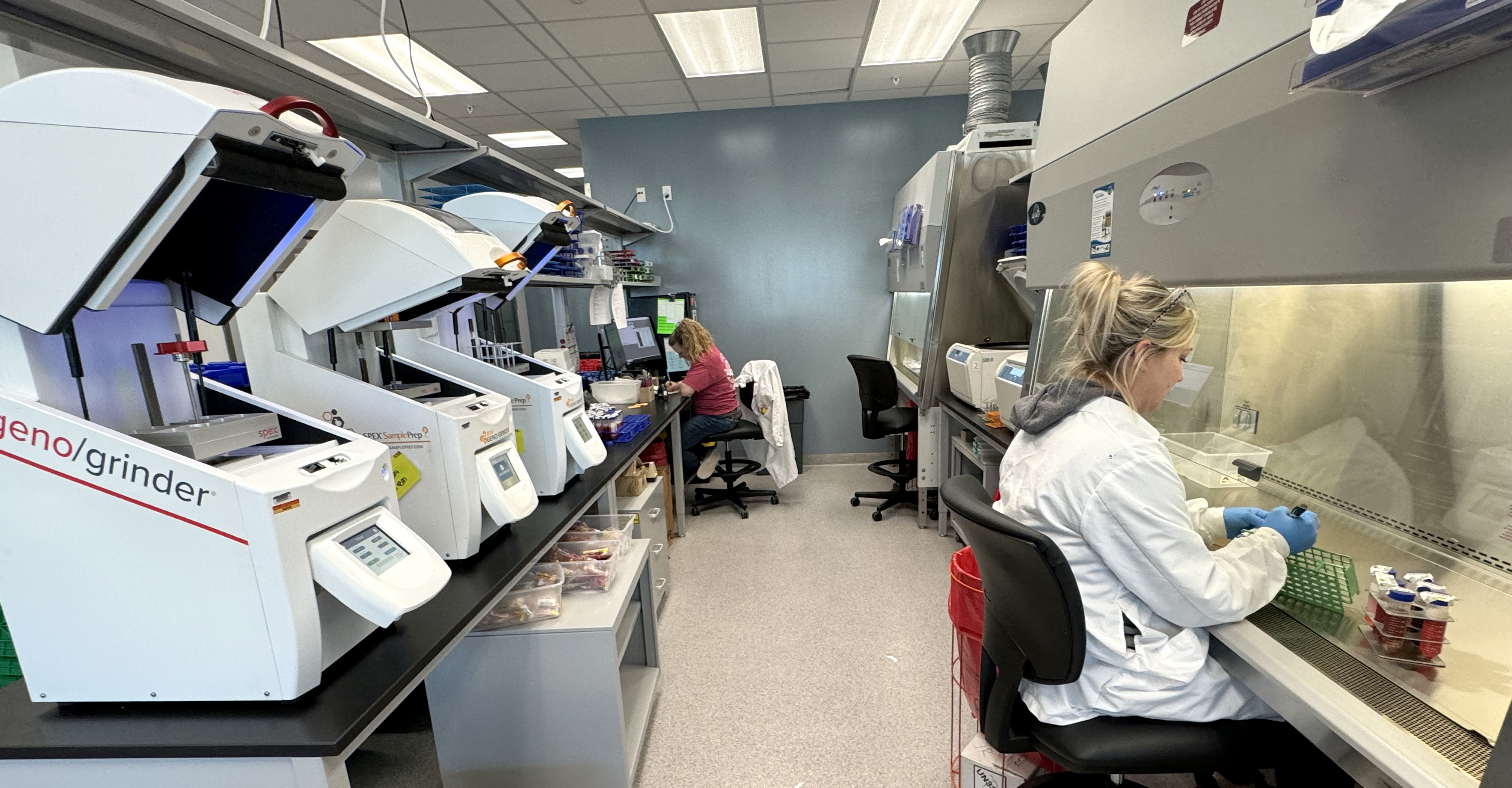
Diagnostic assistant Nichole Smith (right) prepares tissue specimens for PCR (polymerase chain reaction) testing. Beyond Smith, diagnostic assistant Kiele Rolph organizes tissue specimens received from the necropsy unit.
Wintersteen shares updates at March council meeting
During her visit to the March 7 Professional and Scientific Council meeting, President Wendy Wintersteen noted her Iowa State career began in an extension entomology staff position. She thanked council members for their individual work for the university in support of its teaching, research and extension missions, as well as their service to the council.
"We couldn't run the university without you," she said.
Her discussion with councilors focused primarily on two topics: Iowa State's 2022-31 strategic plan and work toward a university response, due next month, to the state Board of Regents' November directives regarding diversity, equity and inclusion programs and services.
As announced Feb. 15 in Inside, the next call for funding proposals in the strategic plan has been paused, pending more information for salary increases and rising health care costs and their impact on university budgets. A third unknown is whether the 2024 Iowa Legislature will fund two requested increases to Iowa State's appropriations.
She noted the university, which self-funds the employee insurance plan, covers 88% of the cost of the plan; employee premiums pay the rest.
She said strategic plan proposals selected for funding during this fiscal year that outlined a second year of funding will still have that opportunity, and those teams have been contacted.
Wintersteen distributed a handout of the regents' 10 directives, noting 4a, 4b, 5, 7 and 10 already have resulted in changes to the regents' policy manual, and Faculty Senate leaders are addressing directive 6, an update to DEI-related general education categories.
While the university's implementation plan isn't final, Wintersteen said directive 2 gives Iowa State opportunity to continue programs at the division, college, department or unit levels that are available to all students or employees or meet compliance or accreditation requirements.
Discussions are ongoing for compliance with directive 1, which requires the three regent universities to eliminate central, universitywide DEI functions not necessary for compliance or accreditation.
Wintersteen noted a national search for the next Iowa State senior vice president for academic affairs is underway, with the goal of bringing finalists to campus in mid- to late April. Jonathan Wickert is stepping down as provost this summer and remaining on the mechanical engineering faculty. She said a search for the next senior vice president for operations and finance will be announced soon. Shawn Norman left the university in December, and associate vice president for finance services Heather Paris is serving as interim senior vice president.
Officers for 2024-25
Councilors elected these members to one-year officer positions, effective July 1:
- President elect: Jennifer Schroeder, finance service delivery (Birch team)
- Secretary/treasurer: Sara Everson, public safety
- Vice president for communications and community relations: Sarah Larkin, Graduate College (reelected)
- Vice president for compensation and benefits: Liz Luiken, dean of students office
- Vice president for diversity, equity and inclusion: Susan McNicholl, College of Engineering student services (reelected)
Current president Patrick Wall, agriculture and natural resources extension and outreach, Region 18, will move into the past president role on the council's executive committee and president-elect Jason Follett, software engineering, will serve as council president for 2024-25.
Other council business
Committee chairs shared these announcements:
- The annual P&S Council online election is scheduled for March 25-27. The nomination window was extended two weeks, through March 15, to recruit additional candidates in academic affairs, where 13 council terms expire this year. Across the four divisions, 20 seats will be filled in this spring's election.
- Including presenters and participants, 305 P&S employees attended the annual professional development conference for P&S employees Feb. 28, organized by the council's professional development committee.
- At a March 26 CYtation Awards breakfast ceremony, 48 P&S employees will be honored for their exemplary work. A future edition of Inside will announce those award recipients.
2024 Innovation at Work: Designing vibrant communities
Editor's note: This feature is the launch of news service's 2024 Innovation at Work series of stories, photos and videos that highlight economic development and the impact of Iowa State's contributions across the state. A new entry will post every Tuesday through April 23.
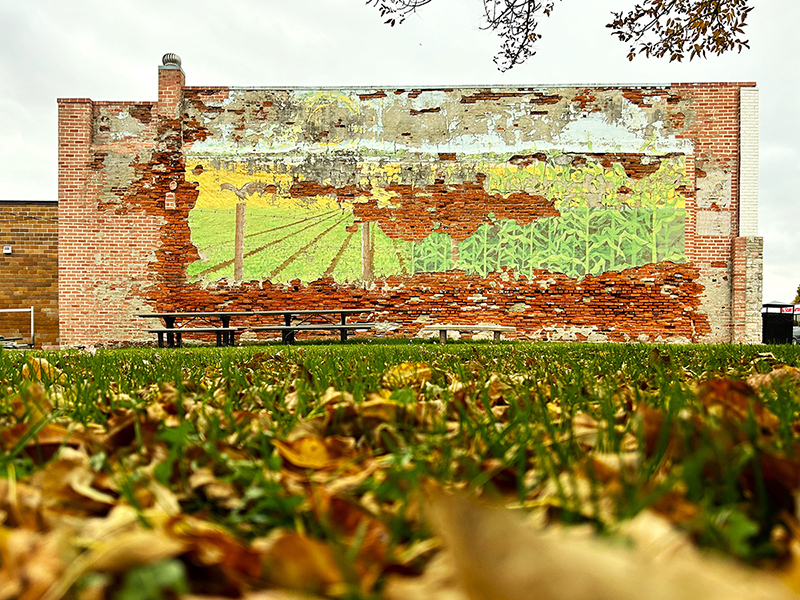
Original downtown mural in Emmetsburg's "Mural Park" pocket park. Photo by Gretchen Reichter.
It's a dry, fall day in northwest Iowa. Gretchen Reichter walks through Emmetsburg's downtown, passing storefronts adorned with scarecrows from a recent retail competition. The community's marketing and development coordinator stops when she reaches a gap between two businesses. Faded murals of sunflowers and a cornfield cling to the brick walls on either side of the pocket park.
Helping Iowa communities
Under the umbrella of Iowa State University Extension and Outreach, Community and Economic Development specialists work with local governments, regional and state agencies, community organizations and others to deliver tailored programs and services related to:
- Civic engagement and equity
- Local government and housing
- Data and technology
- Food systems
- Community and business development
"We want it to be an immersive park and something people really want to spend time in," said Reichter, explaining the plan to add a patio, benches, string lighting and garden beds. "Down the road, we'd like to put in outdoor musical instruments for kids and a pergola for live music and for county conservation to provide outdoor educational sessions."
Across town, Reichter points out several transportation improvements. Flashing beacons urge drivers to slow down near the elementary school. Painted lines on roads separate cars and bikes, and a new trail connects the middle and high schools with the hospital and Iowa Lakes Community College.
These and other project priorities in Emmetsburg emerged from participating in the Iowa's Living Roadways Community Visioning Program in 2020-21. The program is a collaboration between Iowa State University Extension and Outreach Community and Economic Development (CED), the Iowa Department of Transportation, the nonprofit organization Trees Forever, private-sector landscape architects and community stakeholders. Since its creation in 1996, 258 towns have participated, 40 of which have been in the program more than once.
Over a year-long process, experts in landscape planning and design bring community members together to identify challenges and opportunities. For some, this turns into downtown streetscaping with native plants and benches, new trails and better access to waterways. For others, the focus has been on safer pedestrian crossings and routes to schools, welcoming town entrances and stormwater management.
A recent survey led by ISU Community Visioning Program staff found 98% of communities completed at least one project after participating in the program, and nearly half finished four or more.
While the visioning program doesn't fund the projects, each town receives research and design services equivalent to $100,000 -- for free. It also helps connect participants to state and federal grants that can turn design concepts into reality.
As a member of the volunteer steering committee in Emmetsburg, Reichter was instrumental in organizing meetings to collect community input, and she continues to play a big role moving projects forward.
"I really like the Community Visioning Program because it provides dedicated time to focus on issues and priorities that you may not have time to focus on otherwise," Reichter said.
In the future, this could include the transformation of a three-block section between Main Street and Five Island Lake. It's the main corridor to reach the waterfront and where Emmetsburg hosts its Fourth of July events, which draw in residents and tourists from throughout the region.
The design boards show medians with bioswales and native plants, pedestrian lighting, benches and decorative pavers. Reichter said these changes would enhance a space that's part of Emmetsburg's history and culture.
"Some of these projects will hopefully get more bodies downtown to support local businesses, but more broadly, they can help attract and retain our key workforce, like teachers, doctors, to sustain our community. That has a huge impact on the economy moving forward," Reichter said.
Community Visioning Program: "Planning 101"
Julia Badenhope, professor of landscape architecture and Community Visioning's principal investigator, said the program is "like Planning 101 and a springboard to do more." Most of the towns that participate each year have populations under 2,000.
Video
See how Iowa's Living Roadways Community Visioning group works to help Iowa communities improve and thrive.
"One of the things I find amazing about rural Iowa is the civic culture, sense of community trust and this deep connection to the lifestyle and environment. This program works to empower people and build on those cultural dimensions," Badenhope said.
While the program has evolved and expanded over the last 27 years, it's rooted in research Badenhope conducted as a landscape architect for ISU Extension and Outreach.
"During the first three years in that role, I did a deep dive into understanding community action and gaps in design services in rural Iowa. Based on that, I saw an opportunity for extension to step in and bring communities of practice together," Badenhope said.
She developed and piloted the Community Visioning Program with the Iowa DOT. Mark Masteller, the state agency's now-retired chief landscape architect, was there from the start.
"Originally, the DOT was interested in this because we have always permitted people to do plantings on the highway right-of-way, but they often don't have any professional expertise. I remember getting a plan drawn on a napkin," Masteller said. "The Community Visioning Program was a big help to the DOT to have these smaller communities access professional services and get more buildable plans."
Badenhope emphasizes that the program is an "opportunity to weave a web of service" between the public and private sectors across Iowa.
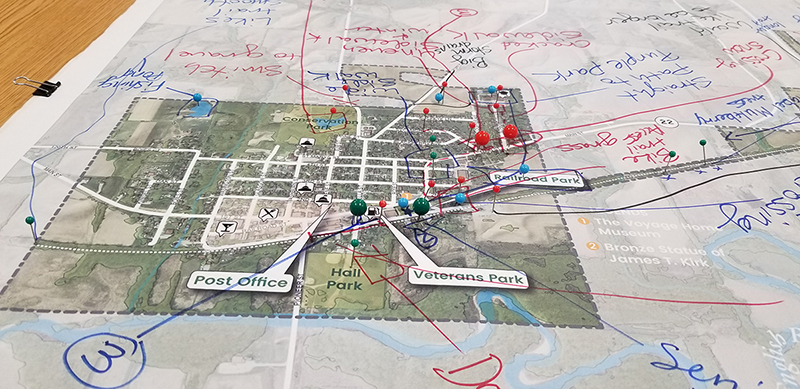
Notes and pins mark a map of Riverside in southeast Iowa from a focus group in 2022. Photo by Sandra Oberbroeckling, Iowa State University.
What’s included in the "web of service?"
Every November, 10 community applicants are accepted into the program. Trees Forever organizes monthly meetings and assessments with each town's volunteer steering committee. Meanwhile, Chad Hunter, a lecturer and project manager with the landscape architecture department, leads a group of student interns to create large maps for each community. They collect data about the local topography, vegetation, watersheds and transportation networks.
In the spring, facilitators from CED, Trees Forever and partnering landscape architecture firms conduct focus groups, using the maps to understand how residents walk, roll and drive across town. They discuss transportation-related barriers and assets and share ideas for improvement.
Sandra Oberbroeckling, Community Visioning Program project manager and CED communications specialist, said it's important to get a wide cross section of the community. Focus groups include people with mobility challenges, parents, youth, older adults and outdoor recreation enthusiasts. In towns with larger populations, the program also conducts a random-sample survey.
"We really want people who live in the communities to take ownership of the projects. If they have more input early on, that's more likely. They may be more willing to volunteer and see the project through to the end," Oberbroeckling said.
After the focus groups meet, Community Visioning Program staff and students distill community input into a series of presentation boards while a private-sector landscape architecture firm assembles an infrastructure assessment. Both go to the steering committee, which prioritizes projects. Residents provide feedback through several public events, and then the landscape architecture firm creates conceptual designs. The firms are required to hire student interns who are involved throughout the process.
By the fall, each community has several fleshed-out project designs with feasibility reports and cost estimates. A Trees Forever field coordinator continues to follow up with the steering committee, providing guidance on implementing projects and applying for grants.
Badenhope explains some towns join the Main Street Iowa Program, which is part of a national initiative aimed at revitalizing historic downtowns. Others work with the Iowa Department of Agriculture and Land Stewardship on urban watershed projects or CED on a community housing assessment.
"Some of these projects are going to be really quick and easy, maybe tree planting or a mural. Other projects are going to take years to implement because the community will wait to implement an enhancement when it's tearing up the street for sewer or gutter improvements," said Jeff Jensen, director of community programs for Trees Forever. "So, it's good to have short-term goals and also some longer-term goals."
Outdoor recreation and disaster recovery
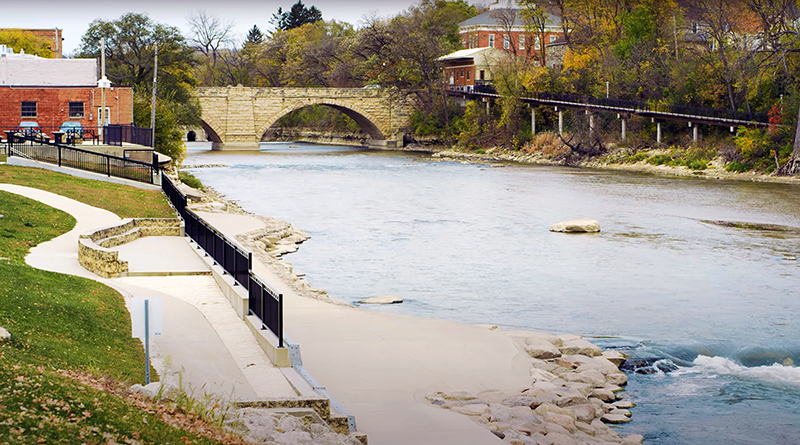
Elkader's ADA-accessible riverwalk and whitewater feature draw locals and tourists to the Turkey River. Photo by Sandra Oberbroeckling, Iowa State University.
Projects that emerge from the Community Visioning Program reflect the needs and priorities of rural Iowa, some of which have shifted over the years.
"When I first started, it was more about entryway enhancements and roadside plantings, which is all still relevant, but it has expanded more to focus on trails and accessibility and healthy lifestyles," Oberbroeckling said.
Looking to the future, the project manager expects more communities will also focus on mitigating and recovering from natural disasters.
"Transportation is not just the roads and sidewalks. It's trees and bioswales, permeable pavement, all of which can help a community be more resilient," she said.
Oberbroeckling points to Mapleton in western Iowa as an example. In 2011, an EF5 tornado destroyed 60% of the town's tree canopy. Through the Community Visioning Program, residents found out the denuded areas had more flooding, spurring projects to improve Mapleton's stormwater management.
The program has aided other communities devastated by tornados, including Parkersburg, and the 2020 derecho.
Elkader, a historic town tucked into a limestone-bluff valley in northeast Iowa, first applied for Community Visioning following record flooding in 2008. The Turkey River that flows through its downtown and stone-arch bridge draws anglers and paddlers from across the region. But after weeks of heavy rain, a surge of water, mud and debris inundated 53 homes and 28 businesses and broke municipal pipes carrying fresh water and sewage.
As the community cleaned up the destruction, the city bought out 30 homes in the floodplain and decided to turn the 11-acre parcel into a park. Community Visioning helped Elkader conceptualize the trails, soccer fields, playgrounds, picnic and performance pavilions, a labyrinth and a butterfly garden. Elkader City Administrator Jennifer Cowsert says Founders' Park provided space for the town to revitalize its annual summer festival and create a new one, the Art in the Park Festival.
A new riverwalk and a whitewater feature for kayakers also resulted from the Community Visioning Program.
"Before the project, the river access was just some concrete stairs. Now, lots of people use the river access for family photos and prom, and of course, recreation. An older resident in a motorized wheelchair goes there to fish regularly, and with the whitewater feature, we've attracted a whole new crowd," Cowsert said.
Similar to nearby towns Manchester and Charles City, Elkader replaced its low-head dam and installed rock features to create waves, eddies and drops. The three towns have a marketing collaboration to attract kayakers from across Iowa and the Midwest.
Elkader participated in the program again during the 2019-20 cycle. The community prioritized connecting more trails and building a pedestrian bridge over the Turkey River for future projects.
"Right now, we have just two buildings downtown that are vacant. For a town our size, that's pretty good. So, I think all of these projects factor into having a strong downtown and quality of life," Cowsert said.
Building momentum for bigger projects
Near the Loess Hills in western Iowa, combines and trucks trace golden fields and fence lines. In the distance, across the Boyer River and the largest remnant of the historic Lincoln Highway, a 65-foot-tall metal corn stalk with LEDs adorns an old grain elevator.
"We like to say the grain elevator 'lights our way home,'" said Deb Sprecker, executive director of Woodbine Main Street. Before the public art installation, the 1940s milk-carton-shaped structure was in danger of being demolished.
"It was considered an eyesore, right at the town's gateway. However, many residents remembered tagging along with grandpa in hopes of a cold soda from the cooler or listening in on lively discussions and local gossip," Sprecker said. "The community rallied to save it, and now it's an iconic piece of Woodbine culture and a quirky 'mile marker' for travelers going from Omaha to Ames."
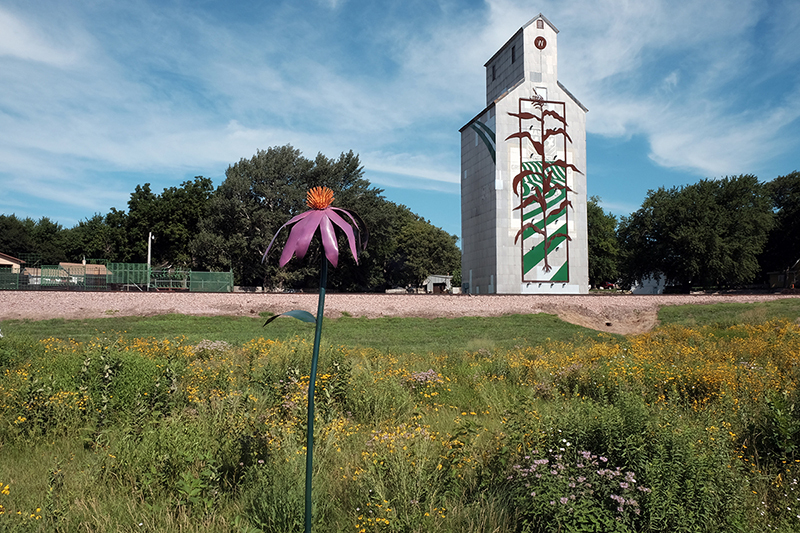
Prairie flowers bloom in front of a metal sculpture adorning a grain elevator at Woodbine's entrance. Photo by Sandra Oberbroeckling, Iowa State University.
Just beyond the grain elevator, brick roads lead to Woodbine's downtown, a National Historic District site. Sprecker points out a building constructed in 1876, the same year as the Battle of Little Bighorn, and said two of the former occupants were the founders of Hy-Vee. A century of micro-tremors from adjacent rail traffic has weakened the mortar in one of the walls, threatening its structural integrity. Current owner Dollie Bothwell, a local florist who serves three counties, is working to renovate the building and save what she calls a "slice of history."
Talking to other business owners and looking at dozens of spruced-up facades, sidewalk sculptures and planters, the story of preservation and economic development repeats itself.
"In rural Iowa communities, the school is the heart of the community, but the downtown is the nerve center," Sprecker said. "In 2008, a lot of our historical buildings were in disrepair. We had 10 vacancies and no restaurants open year-round. Today, we have on average one or two vacancies, a good balance of service and retail and close to 40 upper-story apartments."
Turning the grain elevator into public art and revitalizing the downtown created momentum to tackle other priorities, Sprecker said. A community apple orchard with 500 trees and 40 varieties is a nod to the region's agrarian past and provides free, fresh produce. Across the street, a new wellness center houses an indoor pool, walking track, gym, conference room and child care center for Harrison County residents. And in August, IGNITE Pathways opened its doors to prepare high school students for high-demand jobs and fill a gap in southwest Iowa for continuing technical education for adults.
"Many of these projects stem from Community Visioning during the 2007-08 program year," Sprecker said. "We asked ourselves, what does our community need right now, and what do we want our community to look like in 20 years?"
This past November, the Community Visioning Program hosted its annual celebration. Participants who just wrapped up the year-long process showcased their design concepts, attended grant-writing workshops and met with vendors. For the new cohort, it was an opportunity to see what’s possible and ask questions. In the fall, they'll return to share what they've learned and their plans for the future. It's all part of a growing "web of service" to support vibrant small towns across the state.
Fall course registration (in Workday) begins next week
Editor's note: Returning students will begin registering for fall semester classes next week -- for the first time in the Workday system. On March 20, students received the email below from the WorkCyte team on preparing to use the new system. Inside is sharing it with advisors, faculty and other employees in student services roles to help them prepare, too.
Greetings, Cyclone!
Registration for fall 2024 courses begins soon! When your registration day and time arrives, you'll use Workday to register for fall 2024 courses.
You can log into the Workday app on your Sign On Dashboard, login.iastate.edu. As a reminder, registration and schedule changes for spring and summer 2024 courses still take place in AccessPlus.
Learn how to register for courses in Workday by watching the video in this registration how-to article.
Before registering, there are a few other important things you must do:
- Complete Onboarding tasks in Workday. You must complete your Onboarding tasks, otherwise you will be unable to register for fall 2024 courses.
- View your registration date/time. There may be differences in your registration date/time for summer 2024 versus fall 2024 (summer = use AccessPlus; fall = use Workday).
- Check your holds.
- Know how to submit a prerequisite override. New for fall 2024: prerequisites will be fully enforced and checked at the time of registration, not after.
- Learn about course waitlists.
Help and support
The transition to Workday is a big change, and we're here to provide you the right tools for learning how to use this new technology.
- Visit the student training webpage for how-to articles and demo videos about using Workday.
- Go to a Workday College Help Room.
- Search the ISU Service Portal. Use the search bar in the middle of the page and type in your keyword.
- Contact the IT Solution Center by submitting a help ticket, calling 515-294-4000, or visiting 192 Parks Library.
Thank you,
The WorkCyte Program
A peek inside the Therkildsen building
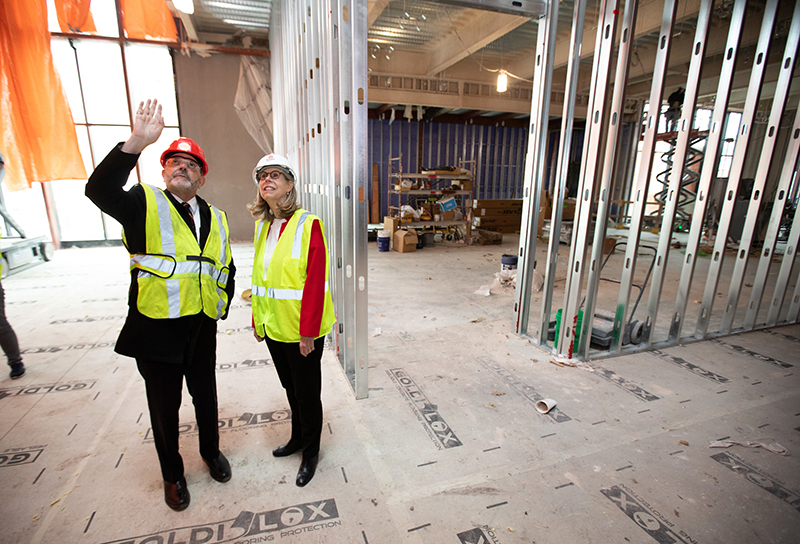
Engineering dean Sam Easterling explains facility details to President Wendy Wintersteen during a March 8 tour of the Therkildsen hall construction site, the future home of the industrial and manufacturing systems engineering department. Photos by Christopher Gannon.
Construction of the Therkildsen building, the future home of the industrial and manufacturing systems engineering department, has cleared the halfway mark and remains on schedule for completion late in the fall semester, with equipment, IT and furniture installation to follow. The building is going up north of Thielen Student Health Center on the west edge of campus.
Crews currently are working inside on utilities infrastructure, for example, water piping, heat and cooling ductwork, bathroom plumbing, electricity conduit runs and trays for IT cables. Wall framing has started on all floors with level two the furthest along and perhaps ready for drywall later this month. Window installation also has begun, including several glass curtain walls at the building's corners. Once the windows are all in, work on the building's exterior surfaces -- some precast concrete panels and metal cladding on the upper floors -- can begin.
Besides drywalling, next-up tasks are wiring, lighting and installing elevators and the building's fire safety system.

This second-floor opening to the main level below is one of two such features in Therkildsen Hall. This south side of the second floor is designated for faculty offices.
